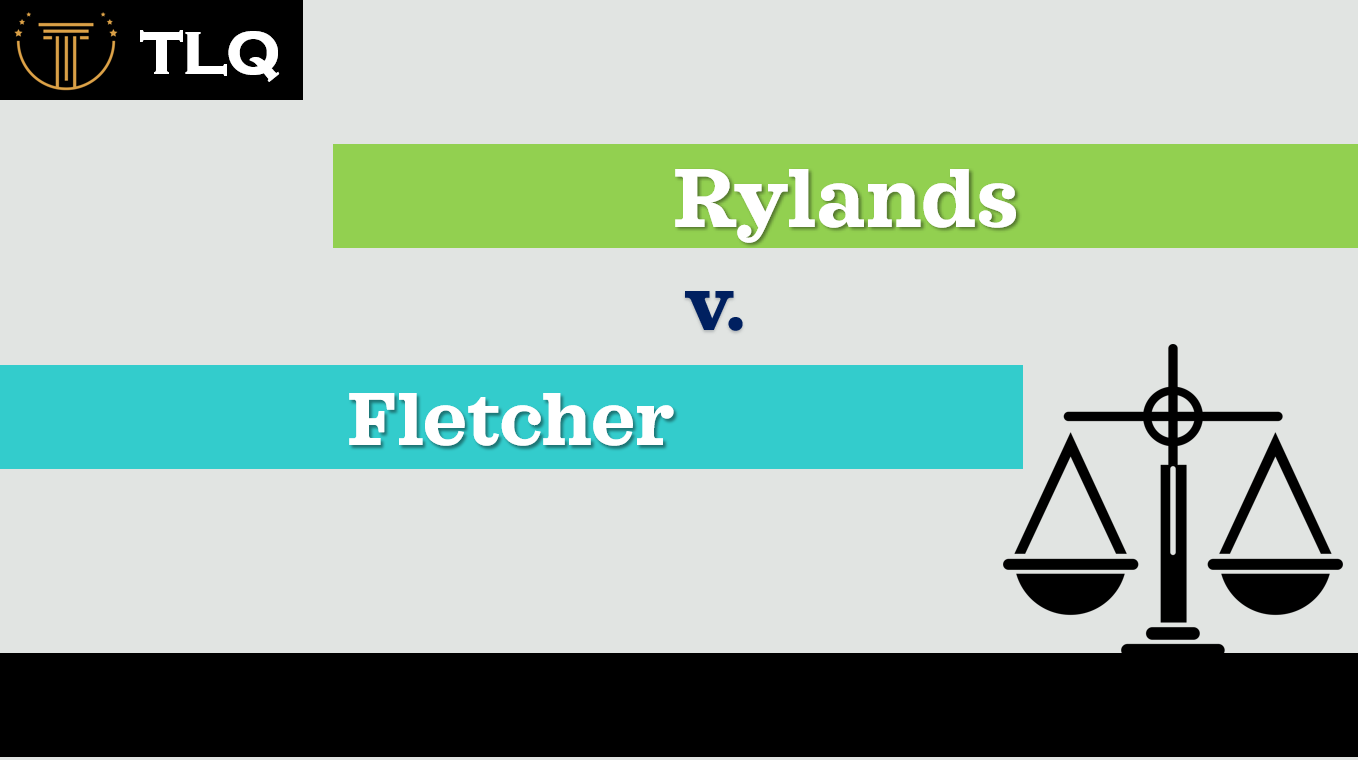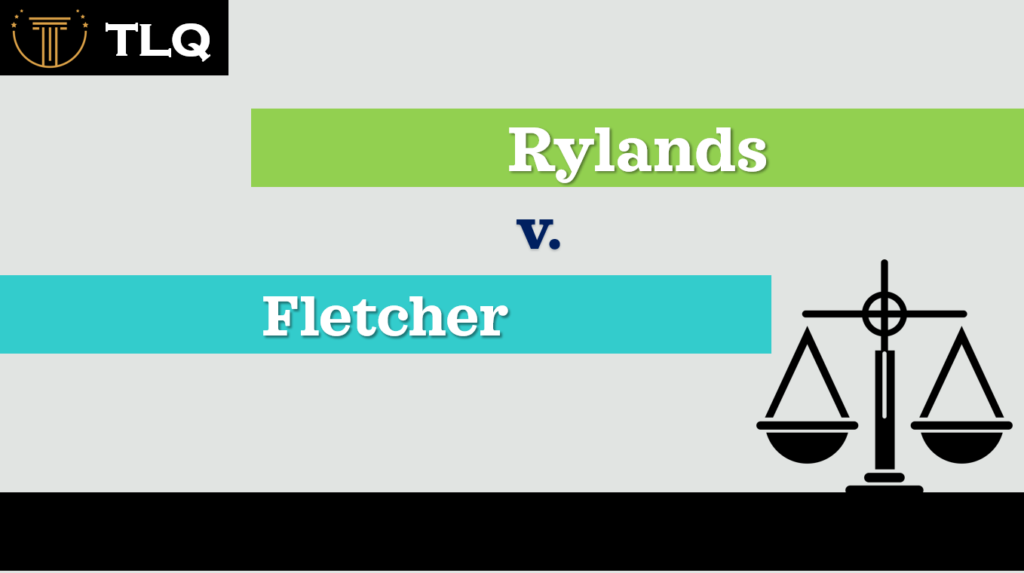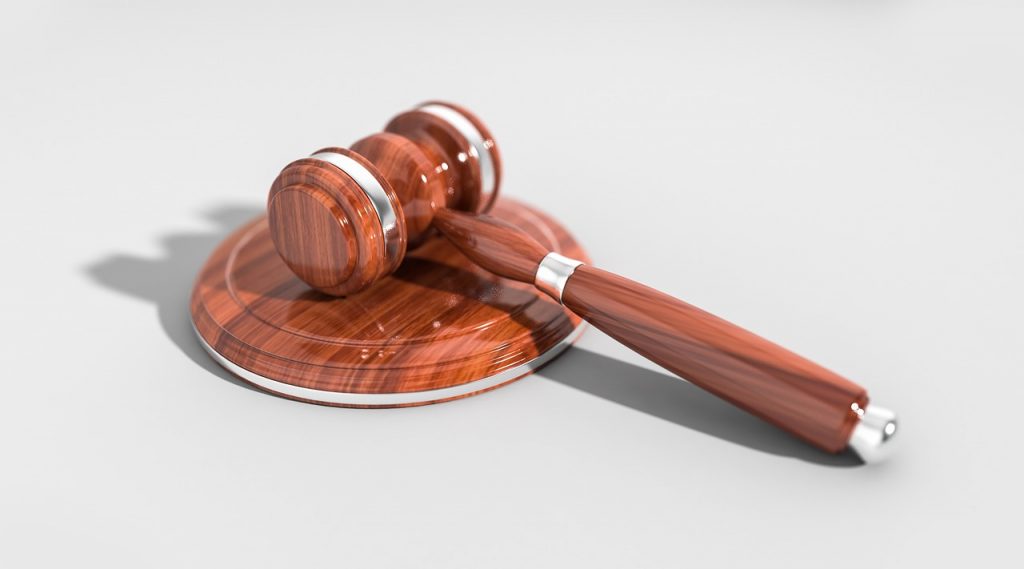Published On: 25th May, 2024

Authored By: Prasad C. Mali
MIT World Peace University, Pune
CASE Name- Rylands Vs Fletcher
Citations– UKHL 1, L.R. 3 H.L. 330.
Judgement of the case — July 17, 1868
Author – Prasad C. Mali, Legal Intern at the Legal Quorum
ABSTRACT
This research paper delves into the landmark case of Rylands v. Fletcher, exploring its historical background, legal principles, and contemporary relevance. It originated from a dispute over water leakage from a reservoir in the 1800s in England, this case also established the legal principle of strict liability. For unnatural or non-natural use of land. Through a comprehensive analysis, the paper examines the legal foundation of the case’s legal basis, criticisms, and early interpretations with related legal doctrines like nuisance law, absolute liability, and vicarious liability in tort. Additionally, it also examines the contemporary application of Rylands v. Fletcher through case studies.
INTRODUCTION
The Rylands v. Fletcher case was ruled by the English Court in 1868. The case mainly originated from a disagreement regarding the leakage of water from a reservoir, which resulted in harm to the adjacent owner of the land. This case mainly set the preceding legal principle on strict liability for non-natural use of land.
LEGAL BACKGROUND AND HISTORICAL CONTEXT OF THE CASE
- Context of the Case
Rylands v. Fletcher appears from a conflict between two neighboring landholders during the time of the 1800s in England, UK. Here the claimant, Thomas Fletcher was having a coal mine which was adjoining Rylands’s land, here defendant. One day Fletcher raised a reservoir on his property to withhold the water. Unknown to Fletcher, the reservoir was built above the abandoned mine shafts which was Ryland’s property.
The bursting of the reservoir caused a significant flood in the Ryland mines. Hence causing him expensive damage. After all these things Rylands files a lawsuit against Thomas Fletcher, claiming negligence in the construction of a reservoir and not keeping maintenance of it. The case moved to the English court and ultimately resulted in a landmark judgment in English tort law.
- Establishment of Legal Principals.
Blackburn J., in his judgment in the court of exchequer chamber. He held that Fletcher is responsible for the damages caused to the Rylands even if negligence is absent on Thomas Fletcher’s part. This case Rylands vs Fletcher establishes the key principle of strict liability, that the harm resulting from the release of hazardous substances gathered on the defendant’s land, as long as the activity constituted an unnatural utilization of the land.
- Criticisms
The case of The Wagon Mound1 case provided an interpretation of the concept of foreseeability as compared to Rylands v Fletcher. They clarified that liability under this depended on the foreseeability of resulting harm. Which is the requirement of a direct and immediate connection between the actions that occurred by the defendant and the damages that have occurred.
Further, the case of Ponting v Noakes2 offered additional things regarding the scope of liability under the case of Rylands v. Thomas Fletcher. The court established the fact that, in the situation where the defendant did not directly cause the release of hazardous substance but played the role of its accumulation on the property which is being observed here.
COMPREHENSIVE ANALYSIS OF RYLANDS V. FLETCHER
- Rule of law
The Rylands v. Fletcher doctrine establishes the specific conditions that need to be there for liability to be established. Firstly, there should be a presence of potentially harmful substances on the defendants’ property, which is also known as the “non-natural user” principle. Secondly, there should be an escape of property from the defendant’s land, in this situation it doesn’t matter if the defendant has any intent or not. But if it has escaped, the defendant will directly be liable even if reasonable precautions were taken. Lastly, the escape from the defendant’s property should cause damages to the claimant’s property
[1] Overseas Tankship (UK) Ltd v Mortes Dock & Engineering Co Ltd (The Wagon Mound (No 1)) [1961] AC 388
[2] Ponting v Noakes (1867) LR 2 HL 281II Analysis of Rylands v. Fletcher Doctrine
For example, In the case of Read v. Lyons & co Ltd3 which can be used as an example for the components of the case of Rylands v Fletcher. In the above case, the court ruled that the defendant was liable. Hazardous substances must escape from their land. This case also gave the significance of the establishment of causation in determining liability and emphasized the requirement of a direct connection between the actions of defendants and resulting harm.
- Extent of liability.
The case of Cambridge Water Co. Ltd v. Eastern Countries Leather Plc4 is a Significant case that explores the extent of liability under Rylands vs Fletcher. In this case, the House of Lords clarified that the defendant’s use of the land must be exceptional and inappropriate in the circumstances.
- Exceptions and Defences
Rylands vs Fletcher, despite having strict liability in the case, acknowledges various defenses and exceptions. One of the defenses is consent, the claimant has agreed to the defendant’s use of land or the risk involved. Secondly, the legal principle of the Act of God can be applicable because the escape is due to an unavoidable natural event beyond the defendant’s control. The court has ordered exceptions to liability, for example when the escape is a result of the third party’s action or may be an independent contract hired by the defendant.
The case Ponting v. Noakes5 serves as a notable example of defenses and exceptions under Rylands v, Fletcher. In this case, the court deliberated on the defendant’s claim that water was leakage from his property was a result of negligent action of the “third party”, hence there was no liability on him.
[3] Read v. Lyons & Co Ltd [1947] AC 156
[4] Cambridge Water Co Ltd v. Eastern Counties Leather plc [1994] 2 AC 264
[5] Ponting v. Noakes (1867) LR 2 HL 281
COMPARATIVE ANALYSIS WITH RELATED LEGAL PRINCIPAL
- Nuisance Law
The legal concept of nuisance law, which is guided by the maxim “sic utere tuo ut alienum non laedas” (i.e. use your own property in a such way as not to injure others), gives and bears the same similarities that have been established in the case of Rylands v fletcher, which is mainly emphasis on unreasonable interference and using and enjoying the land. There is a notable difference between these two. Nuisance law includes both private and public nuisances. Private nuisances are something where there is the involve interference with an individual’s use and enjoyment of their land as public nuisances impact the rights of the public at large or certain communities etc. In the case of Rylands vs Fletcher, it does not require the escape of dangerous substances, but the liability may arise from action on the defendant’s property that mainly causes harm or annoyance or problem to neighbor private properties
An example of showing nuisance law is the case of Sturges v. Bridgman6. In this case, the court considered whether the practices or operations of the confectioner’s workshop were causing a nuisance to its neighboring medical practice. Despite having careful and skillful conduct, the court ruled that these activities still constitute a nuisance due to the delicate or sensitive nature of medical practice.
- Absolute liability or Strict liability
This distinction between Absolute liability and Strict liability is one of the most crucial things to understand the nuances of tort law. Absolute liability holds a defendant accountable whether there is a fault or negligence, following the legal maxim “re ispa loquitur” (things speak for themselves), whereas strict liability similarly does not require proof of fault, but it is mostly dependent on specific conditions.
[6] Sturges v. Bridgman (1879) LR 11 Ch D 852
for example in the case of Rylands vs. Fletcher, the release of hazardous substances.
There is a case that gives a prime difference between absolute liability and strict liability. In the case Donoghue vs Stevenson7, the court in Donoghue established the principle of strict liability in product liability disputes, owing the duty of care to manufacturers to ensure to the customers that their products are safe and suitable for the consumers. This case mainly demonstrates the implementation of strict liability concepts and emphasizes the significance of accountability in safeguarding consumers.
- Vicarious liability in the law of tort
Vicarious liability is governed by the legal maxim “Qui facit per alium facit per se” (i.e. he who acts through other acts himself), which is a legal principle where one party can be responsible for the wrongful acts or omission or another party, which is usually an employee or an agent, even if the owner/former did not directly commit the crime or act. It is different from strict liability as it is based on the principle of agency and control rather than the escape of hazardous or dangerous substances. Yet both these are held accountable for the actions of others.
In the case of Lister v. Hesley, all LTD8 serves as a significant example that explains the vicarious liability. In Lister, the bench held that an employer can be held accountable for sexual assaults perpetrated by an employee against vulnerable individuals under their care. This case hence emphasized the fundamental principle that employers can be held liable for the wrongdoings action of their employees when they are scope of employment and when the action has been occurred.
[7] Donoghue v. Stevenson [1932] AC 562
[8] Lister v. Hesley Hall Ltd [2002] 1 AC 215
CONTEMPORARY APPLICATION AND RELEVANCE.
- Case Studies from various jurisdictions In the Case Transco plc v. Stockport Metropolitan Borough Council9 where the release of gas from a pipeline has led to harm to the nearby properties and people living in the area. The court said that pipeline operators would strictly be responsible under the Rylands v. Fletcher doctrine, which we have discussed above emphasizes the importance of accountability for the harm which was caused by dangerous and risky activities.
In another case of Transco v. United Utilities Water plc10, the escaping of water from the water main led to flooding and hence caused damaging the properties. The court applied the doctrine of Rylands vs Fletcher and held the water company strictly liable for the escape of water and damaging the property.
Another case is Bucardo SA v. Star Energy UK Onshore LTD11, in this case, there was an involvement of subsidence damage to the neighboring properties due to the extraction of oil from underground reservoirs. The court here also applied the Rylands v. Fletcher doctrine legal principle and held the oil extraction company liable for the damages caused by the subsidence.
- Environmental Implications
The Rylands vs Fletcher doctrine has Significant implications for environmental law, especially in situations related to pollution and environmental damages. For example, in the case of Attorney General v. Corrigan12, the release of pollutants into rivers has led the contamination and harm to the marine ecosystem. Here, the court applied the principle of strict liability under the case of Rylands vs Fletcher to hold liable the polluter who has caused the environmental damages to the river.
Similarly in the case of Hunter v. Canary Wharf Ltd13, health concerns, and property devaluation were mainly attributed to electromagnetic emissions from telecommunication. But the court ruled in favor of the defendant, it raised important questions about the scope of liability for environmental impacts.
[9] Transco plc v. Stockport Metropolitan Borough Council [2004] 2 AC 1
[10] Transco v. United Utilities Water plc [2005] EWCA Civ 399
[11] Bocardo SA v. Star Energy UK Onshore Ltd [2010] UKSC 35
[12] Attorney-General v. Corrigan [2016] EWHC 214 (Ch)
[13] Hunter v. Canary Wharf Ltd [1997] AC 655
- Policy consideration and future trends
The principles established in Rylands vs. Fletcher are exerting a growing influence on policy consideration and future trends in the law of torts.
In cases such as Cambridge Water Co. Ltd v. Eastern Countries Leather Plc14 and Transco Plc v. Stockport Metropolitan Borough Council, there has been a need for regulatory frameworks to address risks which are being related to dangerous and hazardous activities. These cases have highlighted the importance of taking proactive measures to prevent harm and promote sustainability.
CONCLUSION
The case of Rylands vs Fletcher has significantly influenced the development of the law of torts. especially in defining strict liability. The courts still refer to this case when dealing with similar issues like dangerous activities and environmental damages. the case offers an in-depth understanding of how the legal concepts outlined in the ongoing cases can be applied in real-world scenarios. This case emerged during the time of industrial growth and urban expansion. Through its decision on a case concerning water leakage from a reservoir, the court established principles that still have influenced the handling of comparable disputes which are currently on a global scale.
In conclusion, this research paper has provided a comprehensive examination of Rylands vs Fletcher, exploring its historical background, legal foundations, comparative examination, Morden significance, and policy implications. By combining these perspectives, the paper enhances academic discussions and educates legal professionals about this landmark case which is being referred to. It helps in the development of tort law. Through its meticulous examination and detailed exploration, the research paper highlights the lasting importance of Rylands vs Fletcher as a pivotal and most important precedent that encourages discussions on matters of responsibility, liability, and Fairness.
[14] Cambridge Water Co Ltd v. Eastern Counties Leather plc [1994] 2 AC 264
REFERENCES
https://en.wikipedia.org/wiki/Rylands_v_Fletcher
https://www.lawteacher.net/cases/rylands-v-fletcher.php
https://www.legalserviceindia.com/legal/article-8016-case-analysis-rylands-v-s-fletcher.html
CASE AND CITATIONS
[1] Overseas Tankship (UK) Ltd v Morts Dock & Engineering Co Ltd (The Wagon Mound (No 1)) [1961] AC 388
[2] Ponting v Noakes (1867) LR 2 HL 281II Analysis of Rylands v. Fletcher Doctrine
[3] Read v. Lyons & Co Ltd [1947] AC 156
[4] Cambridge Water Co Ltd v. Eastern Counties Leather plc [1994] 2 AC 264
[5] Ponting v. Noakes (1867) LR 2 HL 281
[6] Sturges v. Bridgman (1879) LR 11 Ch D 852
[7] Donoghue v. Stevenson [1932] AC 562
[8] Lister v. Hesley Hall Ltd [2002] 1 AC 215
[9] Transco plc v. Stockport Metropolitan Borough Council [2004] 2 AC 1
[10] Transco v. United Utilities Water plc [2005] EWCA Civ 399
[11] Bocardo SA v. Star Energy UK Onshore Ltd [2010] UKSC 35
[12] Attorney-General v. Corrigan [2016] EWHC 214 (Ch)
[13] Hunter v. Canary Wharf Ltd [1997] AC 655
[14] Cambridge Water Co Ltd v. Eastern Counties Leather plc [1994] 2 AC 264





